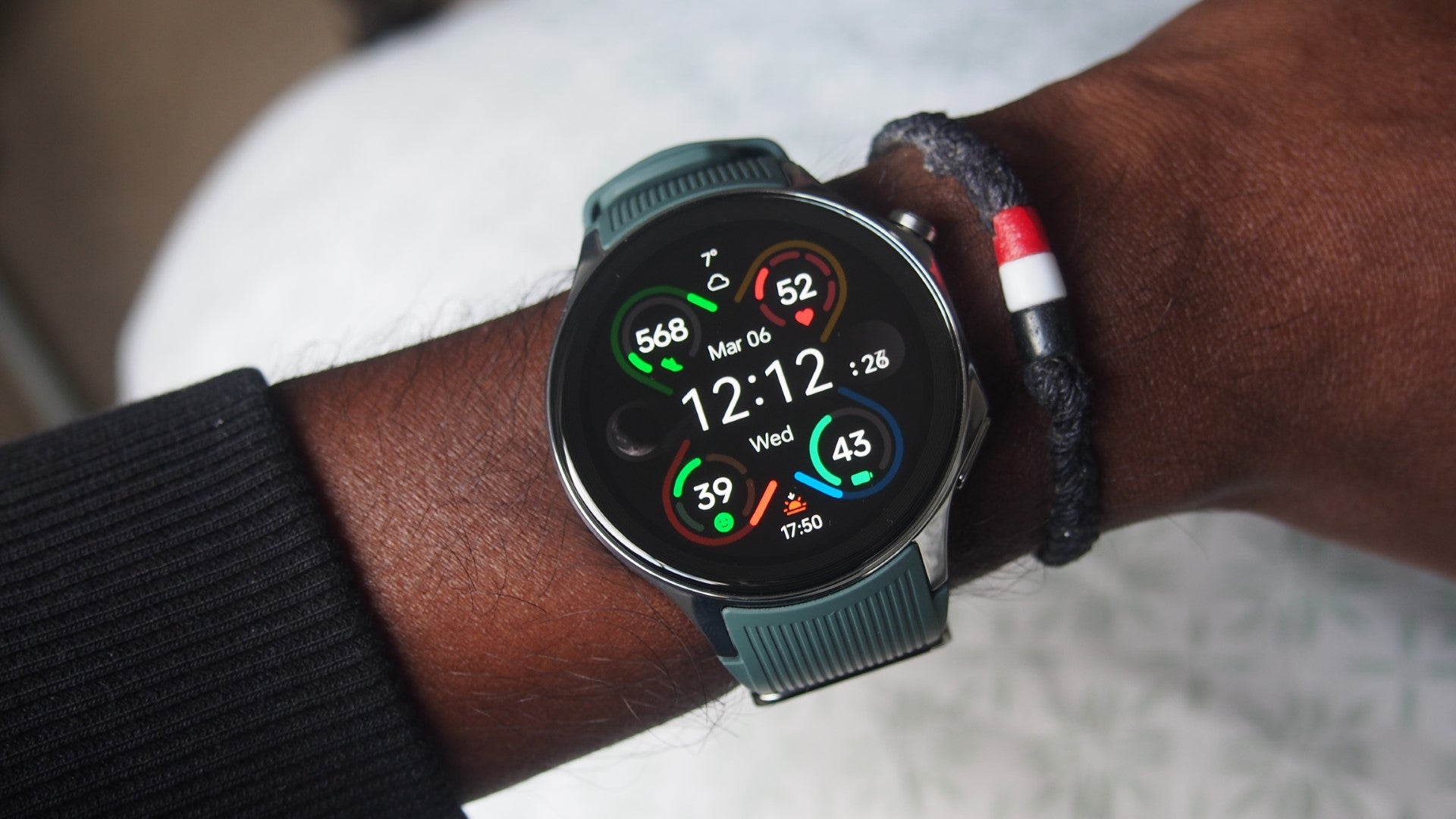Garmin Fenix 7 Review
If you want best in class navigation, mapping and fitness tracking, this is the wearable to get
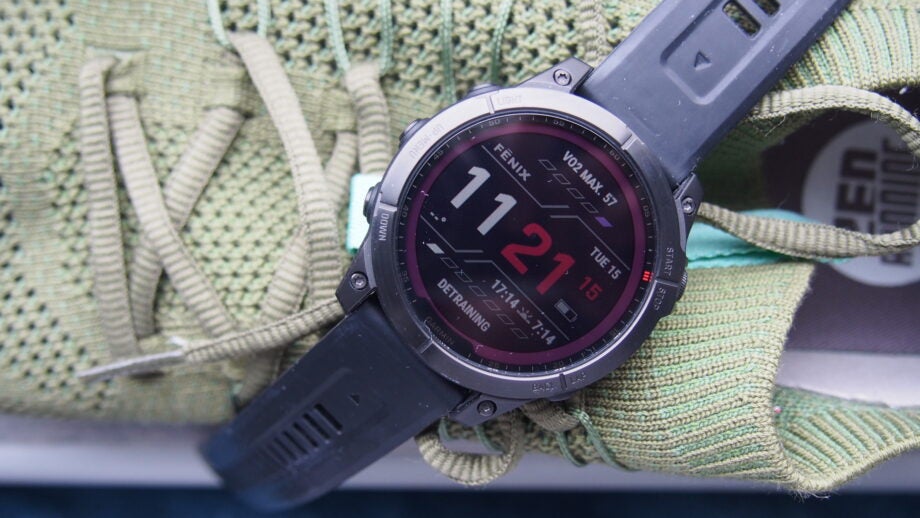

Verdict
The Fenix 7 is a great outdoor watch with new features that make it a worthwhile upgrade from the Fenix 6, if you value supreme outdoor accuracy. During testing we found the device’s increased number of mapping features work brilliantly. Coupled with its radically improved battery life, this makes the Garmin Fenix 7 an excellent investment for any adventurous hiker, runner or cyclist who regularly venture off the beaten path.
Pros
- Strong outdoor tracking accuracy
- Responsive touchscreen
- Improved battery life
Cons
- It’s not cheap
- Not the full smartwatch experience
- Core experience similar to Fenix 6
Availability
- UKRRP: £599.99
- USARRP: $699.99
Key Features
- High-end trackingGarmin’s excellent suite of tracking features are available here including wide mapping support
- Various models availableThere are a couple of models available, including one with solar power
- Great for swimmingAll models carry the same 10 ATM water rating, making them safe to be submerged up to 100 metres depth
Introduction
The Fenix 7 is the latest iteration of Garmin’s outdoor watch that sits between the Fenix 7S and the larger Fenix 7X.
It packs largely all of the same features you’ll find on the 7S and the 7X, including new multi frequency positioning to enhance outdoor tracking accuracy, extended running features, including an improved visual race predictor and a touchscreen, which helps the new Fenix feel more like a smartwatch, rather than a hardcore fitness tracker.
With pricing starting at £599.99/$699.99, the Fenix 7 is a pricey investment, but then that was the same story with the Fenix 6. So, has Garmin made the kind of changes to make this the outdoor watch to own and to make that upgrade? Here’s our take.
Design and Screen
- The 47mm case size is similar to past Fenix watches we’ve tested
- 1.3-inch transflective touchscreen is designed for battery, not brightness
- 10 ATM water rating makes it great for aquatic activities
- Standard, solar and sapphire solar options for those that want longer battery or a more rugged finish
The Fenix 7 looks a lot like the Fenix 6. For people unfamiliar with the line, this means it is an outdoor watch that looks great, feels like it’s built to last and works on land and in the water.
There’s a 47mm case made from polymer and metal with stainless steel and a lighter titanium bezel option available. There’s three Fenix 7 versions up for grabs with the standard coming in the cheapest. Then you can pay more for the 7 solar and the 7 sapphire solar. Having used them all I can confirm whichever you pick, you’ll be treated to a rugged well built tracker that’ll survive event he most gruelling punishments.

The standard version features a Gorilla Glass lens, the solar has a PowerGlass one and then the new sapphire solar I had to test gives you a Power Sapphire lens. That combines the solar powered PowerGlass with the extra protection you get from the sapphire crystal lens. In effect giving you the best of both worlds.
All models carry the same 10 ATM water rating, making them safe to be submerged up to 100 metre depths. That extends to the 22mm silicone strap they’re paired with, which I found comfortable to wear day-to-day, during sleep and for exercise. If you’ve used a Garmin watch recently, this is going to feel very familiar. Thankfully, they also use Garmin’s QuickFit mechanism to make it easier to swap in and out new straps, if you so choose.
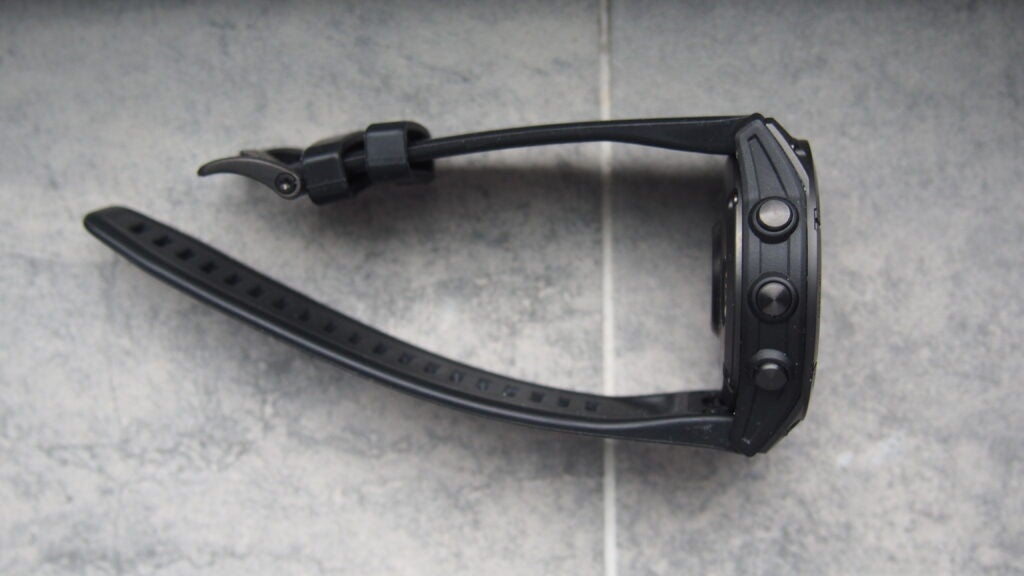
While Garmin has stuck to the same 1.3-inch, 260 x 260 resolution transflective display as the Fenix 6, it’s now giving it the touch treatment. So you can swipe to switch between screens, scroll through Garmin’s Glances (widgets), move around maps and tap to expand notifications. It’s a pleasantly responsive touchscreen and it doesn’t lag either, making its presence mostly welcomed, offering an alternative to the physical buttons to get around the devices UI.
Garmin has stuck to this transflective screen technology because it offers great visibility outdoors and keeps the battery life strong. Which is why during testing it was no surprise the watch delivered on this key area. Granted, it’s not as nice as the colourful AMOLED-toting Garmin watches like the Epix and Venu 2, but it’s easy to glance at and absorb your stats on the move and you do of course have a backlight to brighten things up at night.
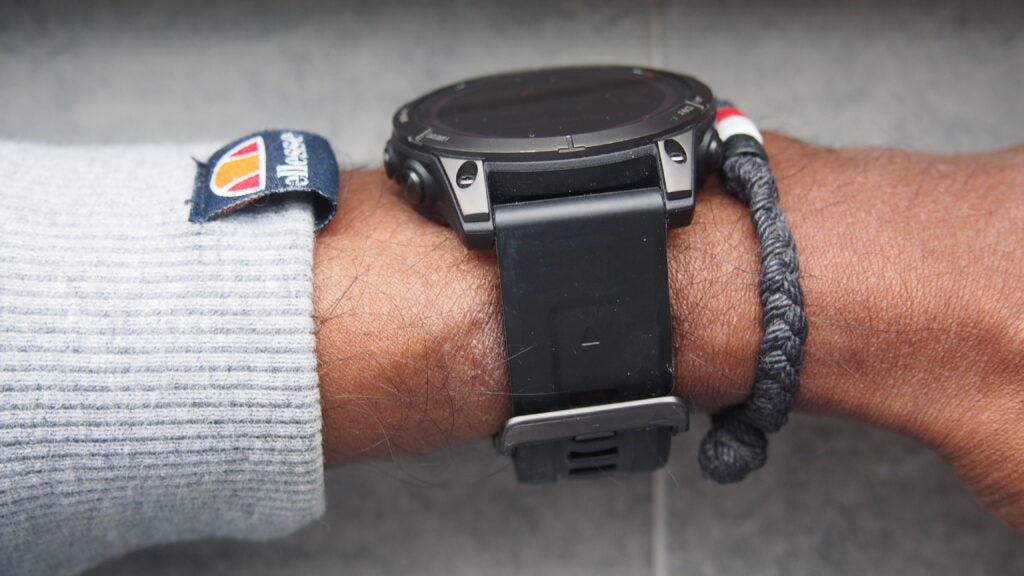
The Fenix 7 is a sleek-looking outdoor watch to live with 24/7. Grabbing it with the titanium bezel makes the already manageable case size a much nicer, lighter one to wear and is a key reason to spend more over the standard version. Grabbing it with the PowerGlass and Power Sapphire lenses is really only useful if you’re going to spend a lot of time outside and can reap the battery benefits the added solar charging brings.
Tracking and Features
- Multi-continent maps
- Turn-by-turn navigation
- Real-time Stamina tracking
- Visual race predictor
- Multi-GNSS support
The Fenix 6 wasn’t and still isn’t a lightweight tracker and offers more than enough features to keep most hardcore athletes happy. So what Garmin is doing with the 7 is taking all the good stuff from the 6 and adding richer tracking metrics, more mapping features and general refinements to its existing features.
There’s all the key outdoor sensors ticked off including an altimeter, barometer and compass with support for GPS, GLONASS and Galileo satellite systems to track your outdoor antics.
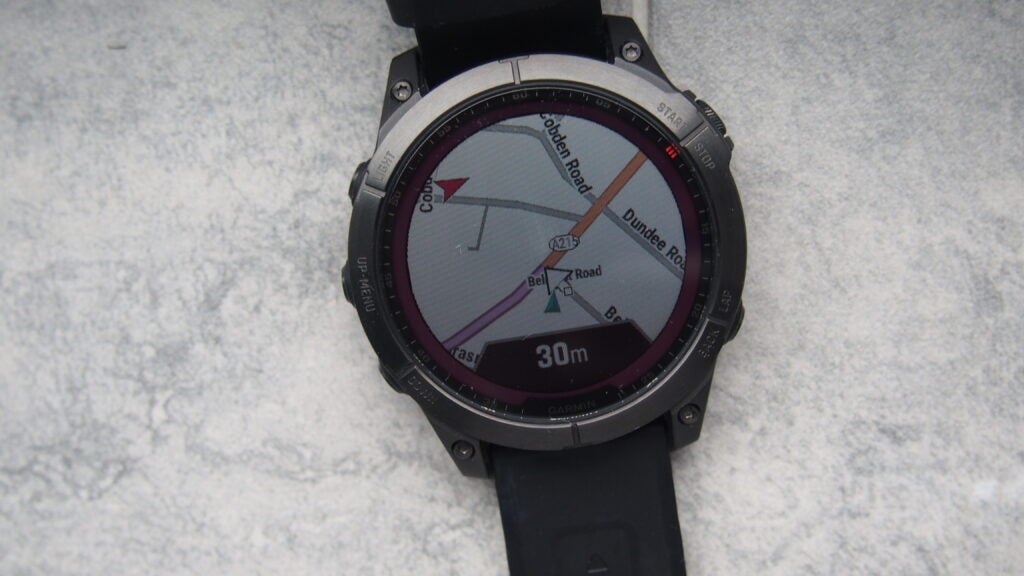
But on the Fenix 7 Garmin has added a new multi frequency positioning mode, which seeks to improve outdoor tracking accuracy in areas the 6 would struggle. The main times this is useful is when trying to track in areas with a lot of tall buildings or highly wooded areas, which can create interference and block the required satellite signals getting through.
This new mode takes multiple frequencies from available satellite systems to offer that supreme accuracy and in my tests against the Fenix 6 Pro, the extra accuracy is there to see. It’s not 100% perfect, but on most of my runs the difference in the mapped routes in the Garmin Connect app showed a clear improvement in tracking performance.
The Fenix has traditionally offered some of the best mapping features on a watch and that doesn’t change on the 7. You’re getting multi-continent topographic maps preloaded and on the odd instance they’re not, more are downloadable (depending on model). It has dedicated maps for golf courses and ski courses worldwide. You can still upload your own routes to the watch as well making it wonderfully flexible.
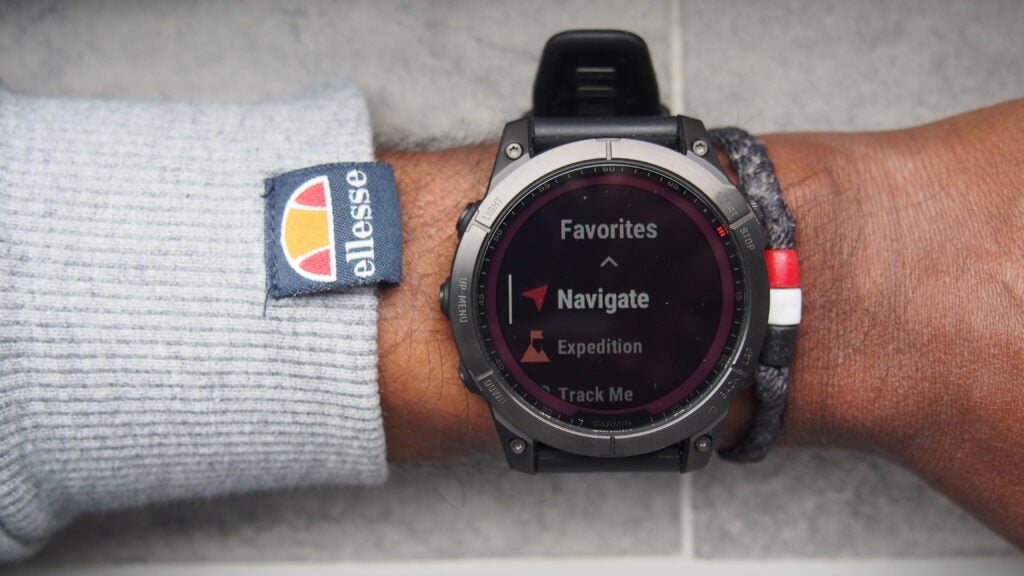
You can the physical buttons or the touchscreen to interact with the 7’s richly detailed maps. Whichever you use, during testing I found the maps are easy to follow on the watch. If you prefer the touchscreen the only minor annoyance I encountered during testing was that some mapping control remains off limits, like pinch and zoom.
Like past Garmin’s I’ve reviewed, I found the 7 offers great turn-by-turn navigation making it great for charting cycle routes as well as hikes. You still have Trackback and Back to the Start modes and for ultra runners. Garmin’s also added a useful Up Ahead mode which alerts you to upcoming water and food stations one on screen.
When it comes to activity and sports tracking there’s a boatload of features on offer. Outside of running, cycling, swimming and golf, there’s an extensive collection of other outdoor modes supported. Paddleboarding, hiking, climbing, skiing, snowboarding are all included along with indoor modes for HIIT and strength training. The HIIT support is taken from the Venu 2 and offers dedicated modes for tracking those fat burning workouts, with some automatic rep counting thrown in that works well, but it’s not perfect for tracking.
If you’re looking at the Fenix 7 to be a watch that can reliably track runs, swims and hikes, it does a fine job on the accuracy front and the range of metrics on offer. Garmin includes the same training load, status and effect insights powered by FirstBeat, which are heavily influenced by heart rate data.
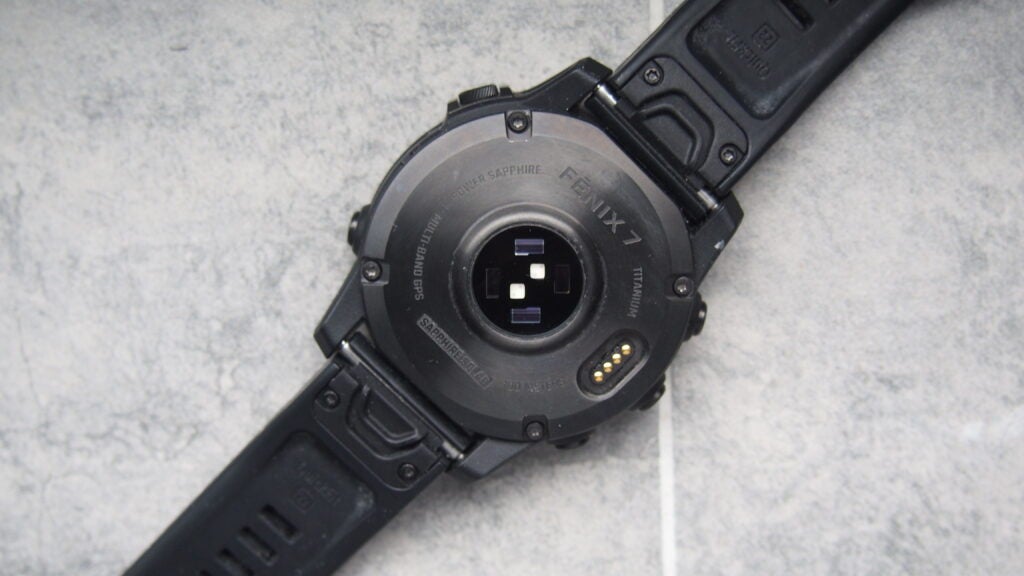
On that front, the watch features Garmin’s latest Gen 4 Elevate optical heart rate sensor, which is fine for continuous monitoring based on my testing, but like a lot of optical sensors, struggles for high intensity exercise. Grab an external heart rate monitor if you’re focused on heart rate-based training or you want to make the most of the onboard training features.
The Fenix 7 also features a Pulse OX sensor letting you track blood oxygen levels continuously or just during sleep. While that does give you another potentially useful metric to monitor your rest at night, the sleep tracking, while improved, still tended to overestimate the time I actually slept for by around an hour on most nights. What is good to see if the sleep widget on the Fenix 7 offers a rich array of information if you don’t want to venture into the app to check out your data.
On top of all this, you get Garmin’s full suite of fitness tracking features, so if you need something to track steps, keeping you moving regularly during the day when you’re not out hiking, the Fenix 7 is very capable of doing that.

For runners, there’s two new features on board here. The first is a visual race predictor, which takes the existing race predictor numbers fuelled by VO2 Max data and historical workout data and adds in graphs to help you get a better sense of why times are dropping.
Then there’s Stamina, which is Garmin’s aim to create a metric and concept that gives you a better sense of what kind of distance or intensity of activity runners and cyclists can tackle without emptying their tank. It’s also designed so you don’t put all of your energy into the first part of your run or ride.
It’s doing that by factoring in your workout history, VO2 Max and training load insights to better understand your capabilities. During a workout with the Stamina screen you can see actual and potential stamina readings illustrated in percentages. Those will fluctuate or stabilise based on those pieces of data. Actual stamina reflects your current heart rate and pace while potential stamina is related to what the watch has learned about you over time.
I can’t say I’ve got entirely onboard with the stamina feature and it certainly doesn’t feel like a feature for running or cycling newcomers either. All to often it’s been out of whack with how my body feels and my actual performance during testing.
Outside of fitness tracking, you can use the Fenix 7 like a smartwatch, letting you view notifications, sync over your own music or music and playlists from the likes of Spotify to listen to sans smartphone and there’s Garmin Pay for contactless payments too. You’re not getting LTE or the ability to take calls via Bluetooth and access your smart assistant like you can with the new Venu 2 Plus, however.

So it’s not the complete Garmin smartwatch experience, but what is here worked well for me. Notifications are easy to read and the touchscreen makes it nicer to scroll through messages. The music player experience is strong too and headphones do seem to pair a bit quicker than they did on the 6 Pro, which is also good to see.
Battery Life
- 18 days in smartwatch mode, 22 days with solar
- 57 hours in full GPS mode (73 hours with solar)
- 173 days in battery saver mode
The Fenix 7’s battery life is largely determined by what you’re going to use on a regular basis. I know that’s the case with most watches, but if you want a couple of weeks or longer, there’s ways to get there.
I found that the Fenix 7 lasted over two weeks with notifications enabled, continuous heart rate monitoring, some music streaming and tracking in the top accuracy tracking mode.
Garmin says you can get up to 18 days in smartwatch mode, which jumps to 22 days with solar charging factored in. GPS battery life is 57 hours (73 hours with solar), but if you use the multi frequency positioning, that drops to 23 hours (26 hours with solar). That’s quite a significant drop-off in tracking mode and was something I experienced compared to tracking with GPS only.
The biggest battery number Garmin quotes for the Fenix 7 is 173 days in its battery saver mode, but that relies on exposing the PowerGlass to enough sun everyday to get that level of battery. I’ve never come close to hitting this during testing.
To make sure you can hit those higher battery numbers, Garmin still includes a Power manager mode to get a better handle of features you use, such as monitoring and looking at your data when you care about it most.
Latest deals
Should you buy it?
You want a great outdoor watch: The Fenix 7, like the Fenix 6 that came before it, is still the outdoor watch to beat.
You just want to track some runs and rides: Unless you’re going to put all of those big mapping, navigation and outdoor tracking features to good use, you could save yourself some money and pay less for a Forerunner.
Final Thoughts
The Garmin Fenix 7 doesn’t bring major design changes over the older Fenix 6. But it’s still a feature-packed outdoor watch that offers best in class mapping, superb tracking and detailed performance metrics. Add to this its more accurate mapping and navigation tracking and extended battery life and it becomes an easy recommendation to any hardcore athlete.
How we test
We thoroughly test every fitness tracker we review. We use industry standard testing to compare features properly and we use the watch as our main device over the review period. We’ll always tell you what we find and we never, ever, accept money to review a product.
Worn as our main tracker during the testing period
Heart rate data compared against dedicated heart rate devices
Side-by-side GPS comparison with competing devices
FAQs
We found that the battery could last over two weeks with notifications enabled, continuous heart rate monitoring, some music streaming and tracking in the top accuracy tracking mode
The Fenix 7 is very similar to the Fenix 6. The main upgrades are improved location tracking accuracy, a lengthier battery life and new touch screen functionality.
Full specs
Below you can see a breakdown of how the Fenix 7’s specs compare to the older Fenix 6 and more expensive Fenix 7X.




